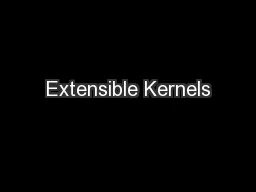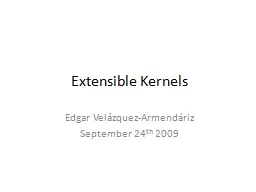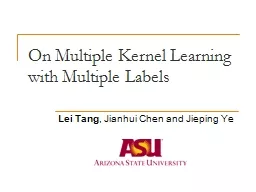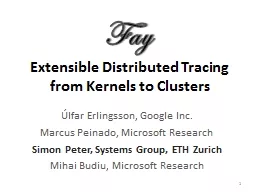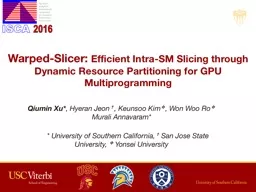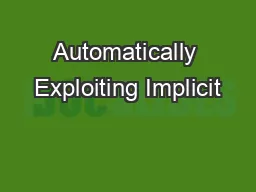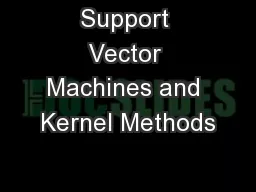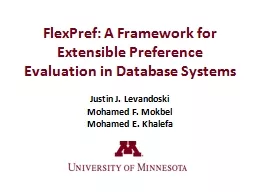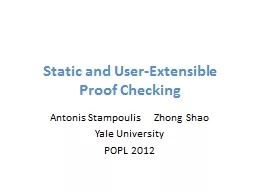PPT-Extensible Kernels
Author : lois-ondreau | Published Date : 2018-01-17
Exokernel and SPIN Presented by Hakim Weatherspoon Based on slides from Edgar Velázquez Armendáriz and Ken Birman 2 Traditional OS services Management and
Presentation Embed Code
Download Presentation
Download Presentation The PPT/PDF document "Extensible Kernels" is the property of its rightful owner. Permission is granted to download and print the materials on this website for personal, non-commercial use only, and to display it on your personal computer provided you do not modify the materials and that you retain all copyright notices contained in the materials. By downloading content from our website, you accept the terms of this agreement.
Extensible Kernels: Transcript
Exokernel and SPIN Presented by Hakim Weatherspoon Based on slides from Edgar Velázquez Armendáriz and Ken Birman 2 Traditional OS services Management and Protection Provides a set of abstractions. g BinetCauchy kernels However such approaches are only applicable to time series data living in a Euclidean space eg joint trajectories extracted from motion capture data or feature point trajectories extracted from video Much of the success of rec Edgar Velázquez-Armendáriz. September. 24. th. 2009. Agenda. Exokernel. : An Operating System architecture for Application-Level Resource Management. Extensibility, Safety and Performance in the . Stephen Mayhew. Hyung Sul Kim. 1. Outline. What are features?. How are they defined in NLP tasks in general?. How they are defined specifically for relation extraction. ? (Kernel methods). 2. What are features?. Also known as “meta-data”. April 2016. Comments in SPICE Kernels. 2. Comments, also called “meta-data,” are information that describe the context of kernel data, i.e. “data about data”. Comments are provided inside kernels as plain text (prose). with Multiple Labels. Lei Tang. , . Jianhui. Chen and . Jieping. Ye. Kernel-based Methods. Kernel-based methods . Support Vector Machine (SVM). Kernel Linear Discriminate Analysis (KLDA). Demonstrate success in various domains. Úlfar Erlingsson, Google Inc.. Marcus . Peinado. , Microsoft Research. Simon Peter, Systems Group, ETH Zurich. Mihai. . Budiu. , Microsoft Research. 1. Fay. Wouldn’t it be nice if…. We could know what our clusters were doing?. Ross McIlroy, Chris Hawblitzel, Galen Hunt. Microsoft Research. Helios: Heterogeneous Multiprocessing with Satellite Kernels. 1. Problem: HW now heterogeneous. Heterogeneity . ignored. by operating systems. Corporate Profile. Engrave Overview . Reliable | Scalable | Extensible | Future-Proof | Best ROI | Best Technology Partner . Products . Reliable | Scalable | Extensible | Future-Proof | Best ROI | Best Technology Partner . . Efficient Intra-SM Slicing through Dynamic Resource Partitioning for GPU Multiprogramming. Qiumin. . Xu*. , . Hyeran. . Jeon. ✝. , . Keunsoo. Kim. ❖. , Won Woo Ro. ❖. . Murali. . Annavaram. Perceptrons. The . perceptron. A. B. instance. . x. i. Compute: . y. i. = . sign(. v. k. . . . x. i. . ). ^. y. i. ^. y. i. If mistake: . v. k+1. = . v. k. + . y. i. . x. i. . x . is a vector. Pipeline . Parallelism from . Multiple . Dependent Kernels for . GPUs. Gwangsun Kim, . Jiyun Jeong, John Kim. Mark Stephenson. GPU Background. CTA. Kernel grid. CTA (Cooperative Thread Array). or Thread block. Machine Learning. March 25, 2010. Last Time. Basics of the Support Vector Machines. Review: Max . Margin. How can we pick which is best?. Maximize the size of the margin.. 3. Are these really . “equally valid”?. Evaluation in Database Systems. Justin J. . Levandoski. Mohamed F. . Mokbel. Mohamed E. . Khalefa. Talk Outline. Preference Methods. Implementing Preference Methods in a DBMS. The Challenge: Extensible Preference Evaluation. Proof Checking. Antonis. . Stampoulis. . Zhong. Shao. Yale University. POPL 2012. Proof assistants are becoming popular in our community. CompCert. [Leroy et al.]. seL4 [Klein et al.]. Four-color theorem [.
Download Document
Here is the link to download the presentation.
"Extensible Kernels"The content belongs to its owner. You may download and print it for personal use, without modification, and keep all copyright notices. By downloading, you agree to these terms.
Related Documents

